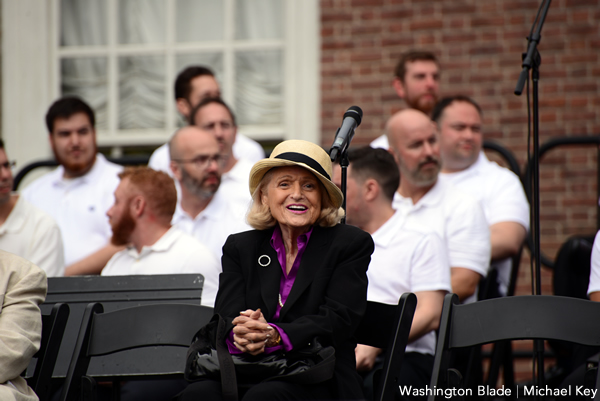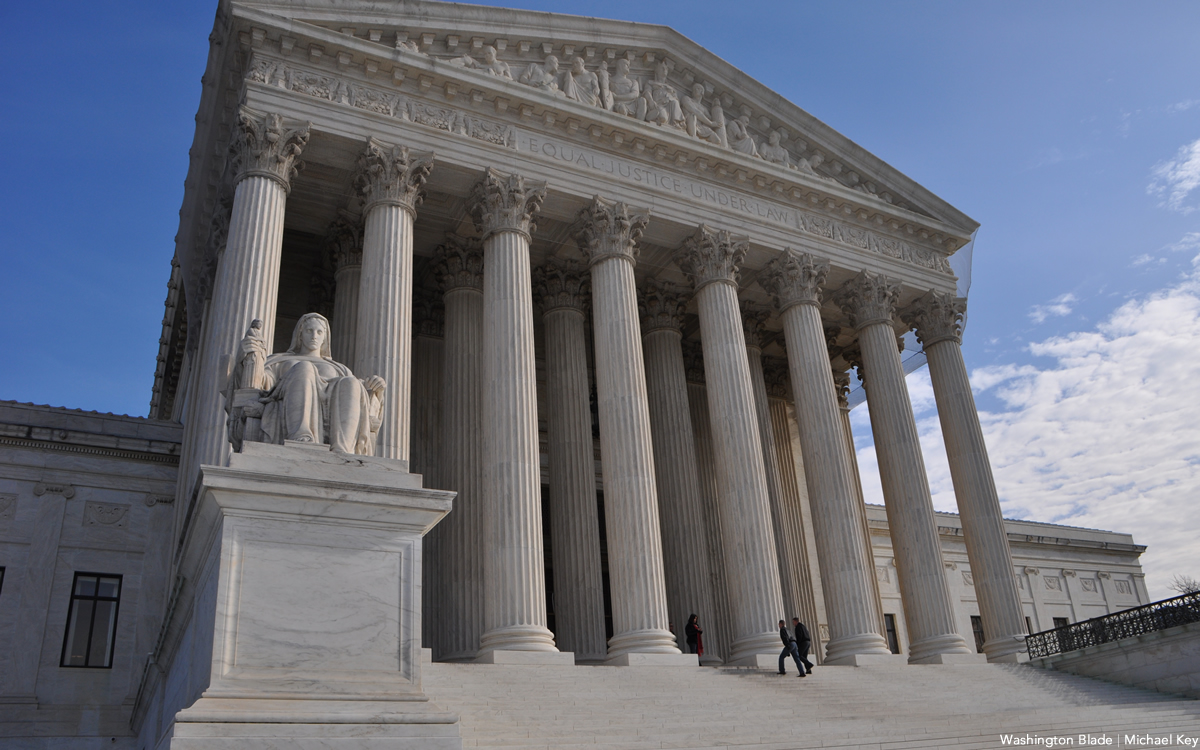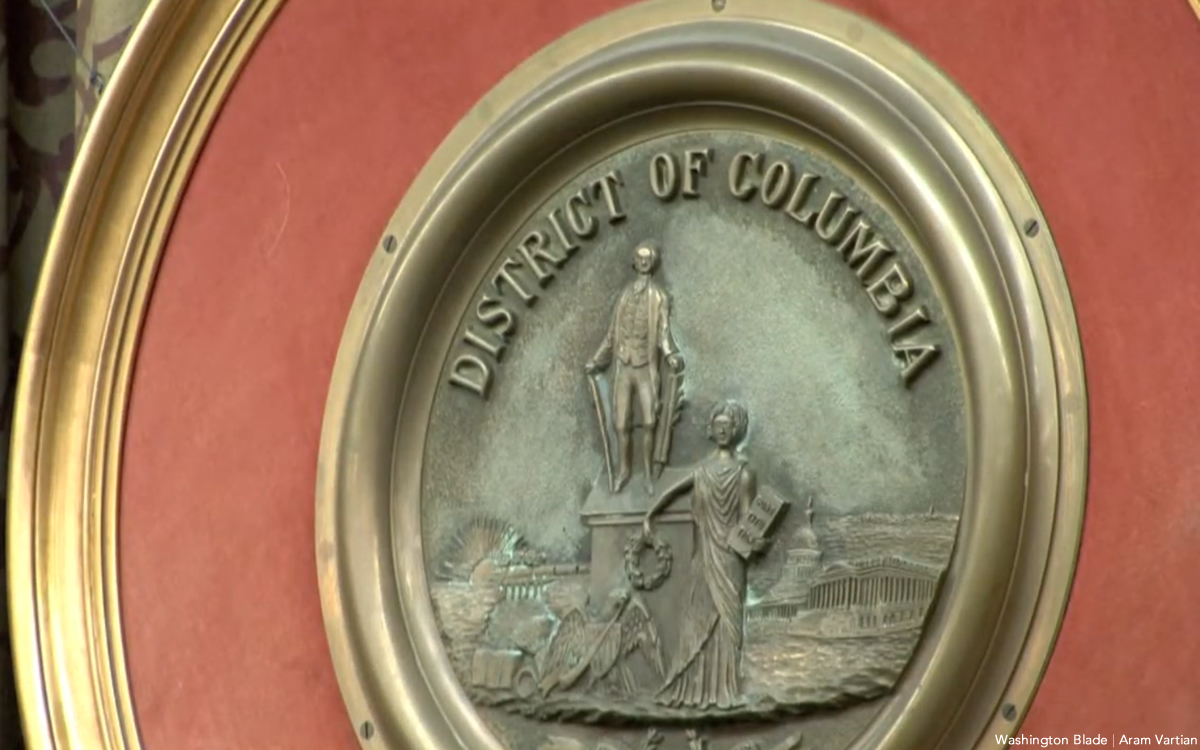Opinions
A big thank you to Edie Windsor
It wasn’t enough for you just to be a gay rights icon


Edith “Edie” Windsor at the LGBT 50th anniversary in Philadelphia. (Washington Blade file photo by Michael Key)
Dear Edie:
From Maine to Mississippi to California – we were all your children. Even if we weren’t your BFF or you hadn’t hugged or taken a selfie with us, we knew you. We smiled when we saw your fab straw hat. When you stood in front of the Supreme Court with your arms outstretched, you were reaching out to your cousin Lewis and his kids. But we felt you were celebrating with us: our community, too, was your family.
Your formal name might be Edith, but you’ll always be Edie to us. Everyone dies, but you were a force of nature. We can’t believe that you, mother to the queer community and the LGBTQ rights pioneer whose case struck down DOMA, died on Sept. 12 at age 88 in Manhattan.
When you met and fell in love with clinical psychologist Thea Spyer in 1963, queer people couldn’t say anything about being gay to their families, co-workers or all but a very few close LGBTQ friends. The idea of gays dancing with, dating or even being seen with, let alone marrying their same-sex loves, was unthinkable. Spyer proposed to you in 1967 with a diamond brooch. Because an engagement ring would have been considered beyond the pale.
Nearly 40 years later, Anne, the late love of my life, was in the hospital. Same-sex marriage wasn’t yet on the horizon. I was only allowed to be with her before she went into surgery because the nurses thought she was my sister.
My story is just one of the multitude of stories of pain and injustice due to marriage inequality that you’ve heard during your decades of LGBTQ activism. The Stonewall uprising catapulted you into queer advocacy. “Until then, I’d always had the feeling – and I know it’s ignorant and unfair – ‘I don’t want to be identified with the queens,’” you told the New York University Alumni Magazine, “But from that day on, I had this incredible gratitude. They changed my life. They changed my life forever.”
It wasn’t enough for you just to be a gay rights icon! Divorced (from a marriage with a man that you early on decided wouldn’t work because you were queer) and living on your own, you earned an M.A. in applied mathematics from NYU in 1957. You became one of a few women to work in a senior position at IBM. This was at a time when most women were homemakers in hetero marriages.
In 1996, President Bill Clinton signed the Defense of Marriage Act. DOMA defined marriage as being between a man and a woman and denied same-sex couples (married where same-sex marriage was legal) federal recognition and more than 1,000 benefits. Because of DOMA when your beloved Thea died in 2009 you had to pay $363,053 in inheritance taxes. (You were married in Canada in 2007.)
I bet you had no idea you’d be the Rosa Parks of LGBTQ rights. But nothing was going to keep you from fighting injustice. Who could count how many lives were enriched when you won your battle to strike DOMA down?
My friend Shannon is among the many to benefit from your battle for justice. It was because of you, Shannon emailed me, “that I was able to get Letty’s Social Security.”
“What a difference she made to this country we love,” President Obama said of you.
You “helped to change hearts and minds, including mine,” Hillary Clinton said at your funeral.
You liked, as you’d say, “to keep it hot.” At your funeral, someone on your medical team said you were scheduled next month to talk to doctors on sex for folks in their 80s. After Thea became quadriplegic through her multiple sclerosis, you talked to the disability community. You weren’t about to give up being passionate with Thea!
Thank you, Edie, for dancing, loving and fighting for us! R.I.P.
Kathi Wolfe, a writer and a poet, is a regular contributor to the Blade.
Letter-to-the-Editor
Candidates should pledge to nominate LGBTQ judge to Supreme Court
Presidential, Senate hopefuls need to go on the record

As soon as the final votes are cast and counted and verified after the November 2026 elections are over, the 2028 presidential cycle will begin in earnest. Polls, financial aid requests, and volunteer opportunities ad infinitum will flood the public and personal media. There will be more issues than candidates in both parties. The rending of garments and mudslinging will be both interesting and maybe even amusing as citizens will watch how candidates react to each and every issue of the day.
There is one particular item that I am hoping each candidate will be asked whether in private or in public. If a Supreme Court vacancy occurs in your potential administration, will you nominate an open and qualified LGBTQ to join the remaining eight?
Other interest groups on both sides have made similar demands over the years and have had them honored. Is it not time that our voices are raised as well? There are several already sitting judges on both state and federal benches that have either been elected statewide or approved by the U.S. Senate.
Our communities are being utilized and abused on judicial menus. Enough already! Challenge each and every candidate, regardless of their party with our honest question and see if honest answers are given. By the way … no harm in asking the one-third of the U.S. Senate candidates too who will be on ballots. Looking forward to any candidate tap dancing!
Opinions
2026 elections will bring major changes to D.C. government
Mayor’s office, multiple Council seats up for grabs

Next year will be a banner year for elections in D.C. The mayor announced she will not run. Two Council members, Anita Bonds, At-large, and Brianne Nadeau, Ward 1, have announced they will not run. Waiting for Del. Norton to do the same, but even if she doesn’t, there will be a real race for that office.
So far, Robert White, Council member at-large, and Brooke Pinto, Council member Ward 2, are among a host of others, who have announced. If one of these Council members should win, there would be a special election for their seat. If Kenyon McDuffie, Council member at-large, announces for mayor as a Democrat, which he is expected to do, he will have to resign his seat on the Council as he fills one of the non-Democratic seats there. Janeese George, Ward 4 Council member, announced she is running for mayor. Should she win, there would be a special election for her seat. Another special election could happen if Trayon White, Ward 8, is convicted of his alleged crimes, when he is brought to trial in January. Both the Council chair, and attorney general, have announced they are seeking reelection, along with a host of other offices that will be on the ballot.
Many of the races could look like the one in Ward 1 where at least six people have already announced. They include three members of the LGBTQ community. It seems the current leader in that race is Jackie Reyes Yanes, a Latina activist, not a member of the LGBTQ community, who worked for Mayor Fenty as head of the Latino Affairs Office, and for Mayor Bowser as head of the Office of Community Affairs. About eight, including the two Council members, have already announced they are running for the delegate seat.
I am often asked by candidates for an endorsement. The reason being my years as a community, LGBTQ, and Democratic, activist; and my ability to endorse in my column in the Washington Blade. The only candidate I endorsed so far is Phil Mendelson, for Council chair. While he and I don’t always agree on everything, he’s a staunch supporter of the LGBTQ community, a rational person, and we need someone with a steady hand if there really are six new Council members, out of the 13.
When candidates call, they realize I am a policy wonk. My unsolicited advice to all candidates is: Do more than talk in generalities, be specific and honest as to what you think you can do, if elected. Candidates running for a legislative office, should talk about what bills they will support, and then what new ones they will introduce. What are the first three things you will focus on for your constituents, if elected. If you are running against an incumbent, what do you think you can do differently than the person you hope to replace? For any new policies and programs you propose, if there is a cost, let constituents know how you intend to pay for them. Take the time to learn the city budget, and how money is currently being spent. The more information you have at your fingertips, the smarter you sound, and voters respect that, at least many do. If you are running for mayor, you need to develop a full platform, covering all the issues the city will face, something I have helped a number of previous mayors do. The next mayor will continue to have to deal with the felon in the White House. He/she/they will have to ensure he doesn’t try to eliminate home rule. The next mayor will have to understand how to walk a similar tightrope Mayor Bowser has balanced so effectively.
Currently, the District provides lots of public money to candidates. If you decide to take it, know the details. The city makes it too easy to get. But while it is available, take advantage of it. One new variable in this election is the implementation of rank-choice voting. It will impact how you campaign. If you attack another candidate, you may not be the second, or even third, choice, of their strongest supporters.
Each candidate needs a website. Aside from asking for donations and volunteers, it should have a robust issues section, biography, endorsements, and news. One example I share with candidates is my friend Zach Wahls’s website. He is running for United States Senate from Iowa. It is a comprehensive site, easy to navigate, with concise language, and great pictures. One thing to remember is that D.C. is overwhelmingly Democratic. Chances are the winner of the Democratic primary will win the general election.
Potential candidates should read the DCBOE calendar. Petitions will be available at the Board of Elections on Jan. 23, with the primary on June 16th, and general election on Nov. 3. So, ready, set, go!
Peter Rosenstein is a longtime LGBTQ rights and Democratic Party activist.
Opinions
Lighting candles in a time of exhaustion
Gunmen killed 15 people at Sydney Hanukkah celebration

In the wake of the shooting at Bondi Beach that targeted Jews, many of us are sitting with a familiar feeling: exhaustion. Not shock or surprise, but the deep weariness that comes from knowing this violence continues. It is yet another reminder that antisemitism remains persistent.
Bondi Beach is far from Washington, D.C., but antisemitism does not respect geography. When Jews are attacked anywhere, Jews everywhere feel it. We check on family and friends, absorb the headlines, and brace ourselves for the quiet, numbing normalization that has followed acts of mass violence.
Many of us live at an intersection where threats can come from multiple directions. As a community, we have embraced the concept of intersectional identity, and yet in queer spaces, many LGBTQ+ Jews are being implicitly or explicitly asked to play down our Jewishness. Jews hesitate before wearing a Magen David or a kippah. Some of us have learned to compartmentalize our identities, deciding which part of ourselves feels safest to lead with. Are we welcome as queer people only if we mute our Jewishness? Are those around us able to acknowledge that our fear is not abstract, but rooted in a lived reality, one in which our friends and family are directly affected by the rise in antisemitic violence, globally and here at home?
As a result of these experiences, many LGBTQ+ Jews feel a growing fatigue. We are told, implicitly or explicitly, that our fear is inconvenient; that Jewish trauma must be contextualized, minimized, or deferred in favor of other injustices. Certainly, the world is full of horror. And yet, we long for a world in which all lives are cherished and safe, where solidarity is not conditional on political purity or on which parts of ourselves are deemed acceptable to love.
We are now in the season of Chanuka. The story of this holiday is not one of darkness vanishing overnight. It is the story of a fragile light that should not have lasted. Chanuka teaches us that hope does not require certainty; it requires persistence and the courage to kindle a flame even when the darkness feels overwhelming.
For LGBTQ+ Jews, this lesson resonates deeply. We have survived by refusing to disappear across multiple dimensions of our identities. We have built communities, created rituals, and embraced chosen families that affirm the fullness of who we are.
To our LGBTQ+ siblings who are not Jewish: this is a moment to listen, to stand with us, and to make space for our grief. Solidarity means showing up not only when it is easy or popular, but especially when it is uncomfortable.
To our fellow Jews: your exhaustion is valid. Your fear is understandable, and so is your hope. Every candle lit this Chanuka is an act of resilience. Every refusal to hide, every moment of joy, is a declaration that hatred will not have the final word.
Light does not deny darkness. It confronts it.
As we light our candles this Chanuka season, may we protect one another and bring light to one another, even as the world too often responds to difference with violence and hate.
Joshua Maxey is the executive director of Bet Mishpachah, D.C.’s LGBTQ synagogue.




















